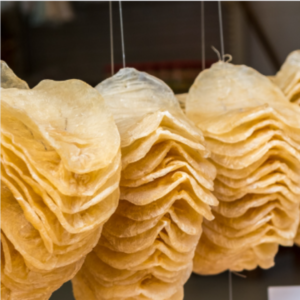Fish maw, the dried swim bladder of certain fish species, is a prized delicacy in many Asian cultures, particularly in Chinese cuisine. Beyond its culinary appeal, fish maw is renowned for its potential health benefits.
Key Health Benefits:
- Rich in Collagen:
- Skin Health: Collagen is a vital protein for maintaining skin elasticity and reducing wrinkles. Consuming fish maw can help promote youthful skin.
- Joint Health: Collagen supports joint health by lubricating and cushioning cartilage. It may help alleviate joint pain and stiffness, especially in older adults.
- High Protein Content:
- Muscle Growth and Repair: Protein is essential for building and repairing tissues. Fish maw can contribute to muscle growth and recovery.
- Weight Management: Protein-rich foods like fish maw can help you feel fuller for longer, reducing overall calorie intake.
- Essential Amino Acids:
- Overall Health: Fish maw contains essential amino acids that the body cannot produce on its own. These amino acids are crucial for various bodily functions, including hormone production and immune function.
- Low-Fat and Cholesterol-Friendly:
- Heart Health: Fish maw is a low-fat food that can help maintain healthy cholesterol levels, reducing the risk of heart disease.
- Potential Anti-Inflammatory Properties:
- Reduced Inflammation: Some studies suggest that fish maw may have anti-inflammatory properties, which can benefit overall health.
How to Incorporate Fish Maw into Your Diet:
Fish maw is often used in soups, stews, and stir-fries. It can be enjoyed by people of all ages, making it a versatile and nutritious food choice.
Note: While fish maw offers several potential health benefits, it’s important to consult with a healthcare professional before making significant dietary changes, especially if you have underlying health conditions or allergies.
By incorporating fish maw into a balanced diet, you may experience the benefits of its rich nutrient profile and contribute to your overall well-being.
Would you like to know more about the culinary uses of fish maw or its cultural significance?





